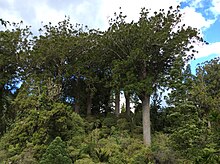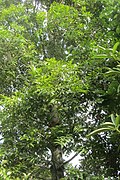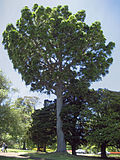
Agathis australis, or kauri, is a coniferous tree in the family Araucariaceae, found north of 38°S in the northern regions of New Zealand's North Island.

Araucariaceae – also known as araucarians – is a family of coniferous trees, with three living genera, Araucaria, Agathis, and Wollemia. While the family was distributed globally during the Jurassic and Cretaceous periods, in their native distribution they are now largely confined to the Southern Hemisphere, except for a few species of Agathis in Southeast Asia.

The gymnosperms are a group of seed-producing plants that includes conifers, cycads, Ginkgo, and gnetophytes, forming the clade Gymnospermae. The term gymnosperm comes from the composite word in Greek: γυμνόσπερμος, literally meaning 'naked seeds'. The name is based on the unenclosed condition of their seeds. The non-encased condition of their seeds contrasts with the seeds and ovules of flowering plants (angiosperms), which are enclosed within an ovary. Gymnosperm seeds develop either on the surface of scales or leaves, which are often modified to form cones, or on their own as in yew, Torreya, Ginkgo. Gymnosperm lifecycles involve alternation of generations. They have a dominant diploid sporophyte phase and a reduced haploid gametophyte phase which is dependent on the sporophytic phase. The term "gymnosperm" is often used in paleobotany to refer to all non-angiosperm seed plants. In that case, to specify the modern monophyletic group of gymnosperms, the term Acrogymnospermae is sometimes used.

Wollemia is a genus of coniferous trees in the family Araucariaceae, endemic to Australia. It represents only one of three living genera in the family, alongside Araucaria and Agathis. The genus only has a single known species, Wollemia nobilis, which was discovered in 1994 in a temperate rainforest wilderness area of the Wollemi National Park in New South Wales. It was growing in a remote series of narrow, steep-sided, sandstone gorges 150 km (93 mi) north-west of Sydney. The genus is named after the National Park.

Araucaria is a genus of evergreen coniferous trees in the family Araucariaceae. While today they are largely confined to the Southern Hemisphere, during the Jurassic and Cretaceous they were distributed globally. There are 20 extant species in New Caledonia, Norfolk Island, eastern Australia, New Guinea, Argentina, Brazil and Chile.
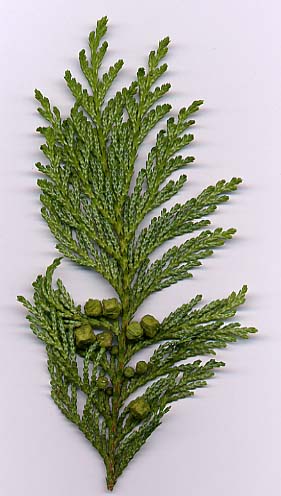
Chamaecyparis, common names cypress or false cypress, is a genus of conifers in the cypress family Cupressaceae, native to eastern Asia and to the western and eastern margins of the United States. The name is derived from the Greek khamai (χαμαί), meaning "on the earth", and kuparissos (κυπάρισσος) for "cypress".

Podocarpaceae is a large family of mainly Southern Hemisphere conifers, known in English as podocarps, comprising about 156 species of evergreen trees and shrubs. It contains 19 genera if Phyllocladus is included and Manoao and Sundacarpus are recognized.
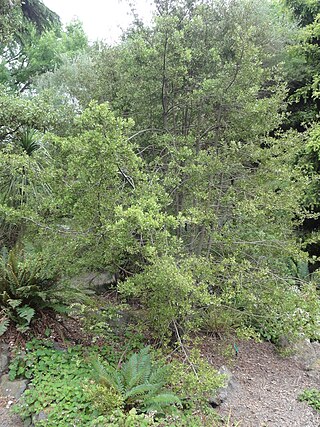
Phyllocladus, the celery pines, is a small genus of conifers, now usually placed in the family Podocarpaceae.Species occur mainly in New Zealand, Tasmania, and Malesia in the Southern Hemisphere, though P. hypophyllus ranges into the Philippines, a short way north of the equator.

Nageia is a genus of conifers belonging to the podocarp family Podocarpaceae. Nageia includes evergreen shrubs and trees, from one to 54 meters in height. A 2009 treatment of the genus recognized five species. Some authors consider Nageia formosensis to be a separate species from Nageia nagi, thus recognizing six species. The podocarp genera have been reshuffled by various botanists. Most recently, several species formerly classed as Nageia were moved to the new genus Retrophyllum, while Nageia falcata and Nageia mannii were moved to the new genus Afrocarpus.

Afrocarpus is a genus of conifers of the family Podocarpaceae. Two to six species are recognized. They are evergreen trees native to Africa. Afrocarpus was designated a genus in 1989, when several species formerly classified in Podocarpus and Nageia were reclassified.
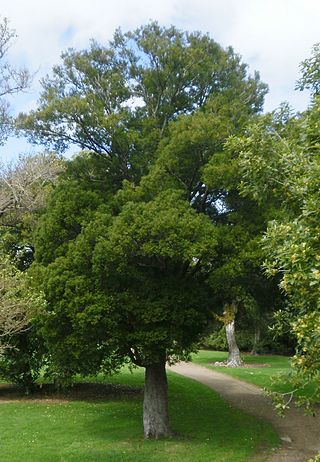
Prumnopitys is a genus of conifers belonging to the family Podocarpaceae. The nine recognized species of Prumnopitys are densely branched, dioecious evergreen trees up to 40 metres in height.

Tāne Mahuta, also called "God of the Forest", is a giant kauri tree in the Waipoua Forest of Northland Region, New Zealand. Its age is unknown but is estimated to be between 1,250 and 2,500 years. It is the largest living kauri tree known to stand today. It is named after Tāne, the Māori god of forests and of birds.

Agathis robusta, commonly known as Dundathu pine, kauri pine, Queensland kauri (pine), Australian kauri (pine) or smooth-barked kauri, is a coniferous tree in the family Araucariaceae. Although sometimes called a pine it is not a true pine, having leaves rather than needles. It has a disjunct distribution, occurring in eastern New Guinea and New Britain in Papua New Guinea and Queensland, Australia.

Athrotaxis is a genus of two to three species of conifers in the cypress family, Cupressaceae. The genus is endemic to western Tasmania, where they grow in high-elevation temperate rainforests.
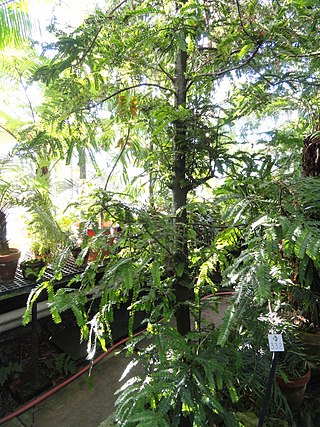
Retrophyllum is a genus of conifers in the family Podocarpaceae. It contains five generally recognized extant species with a disjunct distribution in the Southern Hemisphere, found in Papuasia and also in South America. Retrophyllum are evergreen trees typically occurring in tropical rainforests and cloud forests.
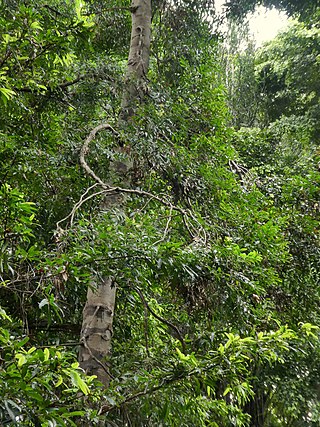
Agathis atropurpurea, commonly known as the blue kauri, and occasionally as the black kauri or purple kauri, is a species of conifer in the very ancient plant family Araucariaceae. The family was distributed almost worldwide during the Jurassic and Cretaceous periods, but is now mostly confined to the Southern Hemisphere. This species is endemic to a small part of northeastern Queensland, Australia.

Agathis ovata, the mountain kauri, is a species of conifer, genus Agathis in the family Araucariaceae. It is found only on the southwest Pacific island of New Caledonia. It is threatened by habitat loss.

Araucaria mirabilis is an extinct species of coniferous tree from Patagonia, Argentina. It belongs to the genus Araucaria.
Araucaria haastii is an extinct species of conifer tree formerly native to New Zealand. A large number of fossilised tree specimens from the family Araucariaceae have been found in New Zealand, but in many cases the level of preservation is not sufficient to reliably distinguish between Araucaria species and Agathis species.
Araucarioides is an extinct genus of conifer belonging to the family Araucariaceae. The type species Araucarioides linearis is known from the Early Eocene of Tasmania, with fossils including isolated leaves, parts of the conifer cone, as well as possible seeds, associated with Dilwynites tuberculatus pollen. Another species only known from leaves, Araucarioides falcata is known from the Late Cretaceous (Campanian) of New Zealand. Phylogenetic analysis suggests that Araucarioides linearis is closely related to both Agathis and Wollemia rather than to Araucaria.
